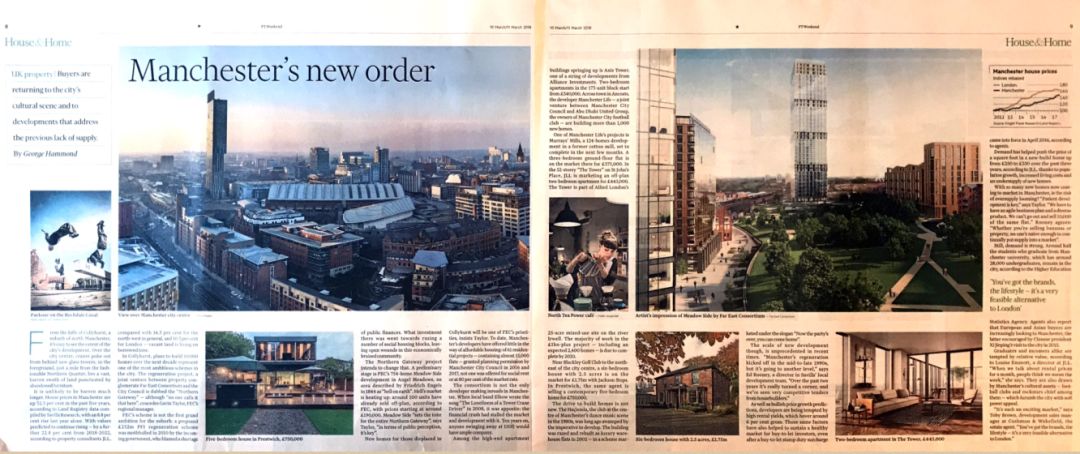英国金融时报(英语:Financial Times,简称FT),是一份以英语发行,财经报导为主,编辑总部位于英国伦敦,以商业和财经新闻为主。英国金融时于2018年3月8日报刊登一篇关于曼彻斯特新趋势的报导,当中介绍了远东发展的「Northern Gateway」计划及Angel Meadows住宅项目。
曼彻斯特新趋势
过去五年,曼彻斯特的整体房价上涨32.5%,比去年增加8.8%。Savills Research预期房价将持续上升,并于2018-2022年间再度增长22.8%。早前,远东发展与曼彻斯特市政府签订协议,合作发展「Northern Gateway」,计划于未来十年建成超过1万个住宅单位。目前,落于Northern Gateway外围的Angel Meadows住宅项目(共754个住宅单位)已录得约100宗成交,成交价为约19万英镑起。远东发展认为Collyhurst将有潜力成为一个由社会基建所支持的新住宅区。现时,曼彻斯特的地产发展商开发了少许大众能负担的房子,包括61个住宅项目,共15,000个单位。事实上,曼彻斯特的重建计划于90年代中后期已经开始变迁,地产业竞争激烈。房价不断上涨,物业之升值潜力租金回报更达6厘。由于人口随年持续增长,生活成本增加以及房屋供应不足,曼彻斯特的房价已从过去三年的每平方英尺250英镑上涨到330英镑。
尽管如此,需求仍然强劲。 根据英国的高等教育统计局的数据,大约一半的毕业于曼彻斯特大学的学生会留在曼彻斯特,该大学有大约28,000名本科生。 代理商还报告说,因为2015 年,国家领导人参观曼城,为买家带来鼓舞,欧洲和亚洲的买家亦有所增长。

Manchester’s New Order
From the hills of Collyhurst, a suburb of north Manchester, it’s easy to see the extent of the city’s development. Over the city centre, cranes poke out from behind new glass towers; in the foreground, just a mile from the fashionable Northern Quarter, lies a vast, barren swath of land punctuated by abandoned furniture.
It is unlikely to be barren much longer. House prices in Manchester are up 32.5 per cent in the past five years, according to Land Registry data compiled by Savills Research, with an 8.8 per cent rise last year alone. With values predicted to continue rising — by a further 22.8 per cent from 2018-2022, according to property consultants JLL, compared with 16.5 per cent for the north-west in general, and 10.3 per cent for London — vacant land is living on borrowed time.
In Collyhurst, plans to build 10,000 homes over the next decade represent one of the most ambitious schemes in the city. The regeneration project, a joint venture between property conglomerate Far East Consortium and the City Council is dubbed the “Northern Gateway” — although “no one calls it that here”, concedes Gavin Taylor, FEC’s regional manager.
FEC’s scheme is not the first grand ambition for the suburb: a proposed £252m PFI regeneration scheme was mothballed in 2010 by the incoming government, who blamed a shortage of public finances. What investment there was went towards razing a number of social housing blocks, leaving open wounds in this economically bruised community.
The Northern Gateway project intends to change that. A preliminary stage is FEC’s 754-home Meadow Side development in Angel Meadows, an area described by Friedrich Engels in 1844 as “hell on earth”. Hell’s market is heating up: around 100 units have already sold off-plan, according to FEC, with prices starting at around £190,000. Meadow Side “sets the tone for the entire Northern Gateway”, says Taylor, “in terms of public perception, it’s key”.
New homes for those displaced in Collyhurst will be one of FEC’s priorities, insists Taylor. To date, Manchester’s developers have offered little in the way of affordable housing: of 61 residential projects — containing almost 15,000 flats — granted planning permission by Manchester City council in 2016 and 2017, not one was offered for social rent or at 80 per cent of the market rate.
The consortium is not the only developer making inroads in Manchester. When local band Elbow wrote the song “The Loneliness of a Tower Crane Driver” in 2008, it was apposite: the financial crash had stalled the market and development with it. Ten years on, anyone swinging away at 150ft would have ample company.
Among the high-end apartment buildings springing up is Axis Tower, one of a string of developments from Alliance Investments. Two-bedroom apartments in the 173-unit block start from £340,000. Across town in Ancoats, the developer Manchester Life — a joint venture between Manchester City Council and Abu Dhabi United Group, the owners of Manchester City football club — are building more than 1,000 new homes.
One of Manchester Life’s projects is Murrays’ Mills, a 124-homes development in a former cotton mill, set to complete in the next few months. A three-bedroom ground-floor flat is on the market there for £375,000. In the 52-storey “The Tower” on St John’s Place, JLL is marketing an off-plan two-bedroom apartment for £445,000. The Tower is part of Allied London’s 25-acre mixed-use site on the river Irwell. The majority of work in the £1bn-plus project — including an expected 2,400 homes — is due to complete by 2020.
Near Blackley Golf Club to the north-east of the city centre, a six-bedroom house with 2.5 acres is on the market for £1.75m with Jackson Stops. In Prestwich, the same agent is selling a contemporary five-bedroom home for £750,000.
The drive to build homes is not new. The Haçienda, the club at the centre of Manchester’s dance music scene in the 1980s, was long ago swamped by the imperative to develop. The building was razed and rebuilt as luxury warehouse flats in 2002 — in a scheme marketed under the slogan “Now the party’s over, you can come home”.
The scale of new development though, is unprecedented in recent times. “Manchester’s regeneration kicked off in the mid-to-late 1990s, but it’s going to another level,” says Ed Rooney, a director in Savills’ local development team. “Over the past two years it’s really turned a corner, and we’ve seen very competitive tenders from housebuilders.”
As well as bullish price growth predictions, developers are being tempted by high rental yields, which hover around 6 per cent gross. Those same factors have also helped to sustain a healthy market for buy-to-let investors, even after a buy-to-let stamp duty surcharge came into force in April 2016, according to agents.
Demand has helped push the price of a square foot in a new-build home up from £250 to £330 over the past three years, according to JLL, thanks to population growth, increased living costs and an undersupply of new homes.
Similar dynamics — most notably price growth and high yields — once lured investors to London, underpinning price growth in the years after the financial crisis. However, by incentivising high-end development, the conditions also planted the seeds of the capital’s current oversupply of luxury flats, with more than half of 1,900 luxury units built in the city last year failing to sell, according to property data company Molior London.
With so many new homes now coming to market in Manchester, is the risk of oversupply looming? “Patient development is key,” says Taylor. “We have to have an agile business plan and a diverse product. We can’t go out and sell 10,000 of the same flat.” Rooney agrees: “Whether you’re selling bananas or property, no one’s naive enough to continually put supply into a market”.
Still, demand is strong. Around half the students who graduate from Manchester university, which has around 28,000 undergraduates, remain in the city, according to the Higher Education Statistics Agency. Agents also report that European and Asian buyers are increasingly looking to Manchester, the latter encouraged by Chinese president Xi Jinping’s visit to the city in 2015.
Graduates and incomers alike are tempted by relative value, according to Louise Emmott, a director at JLL. “When we talk about rental prices for a month, people think we mean the week,” she says. They are also drawn by Manchester’s cultural assets — football clubs and rockstars chief among them — which furnish the city with soft power appeal.
“It’s such an exciting market,” says Toby Brown, development sales manager at Cushman & Wakefield, the estate agent. “You’ve got the brands, the lifestyle — it’s a very feasible alternative to London.”
来源: 金融时报



文章评论